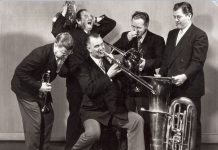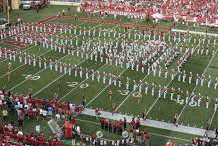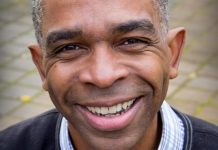(The following interview was first published in the Brass Herald Magazine, October 2014/Issue 55)
An Interview with Michael Grose
Ole Utnes – Welcome to The Brass Herald, Michael!
Michael Grose – Thanks so much for having me. It is a great honor and pleasure.
Before we start talking about Arnold Jacobs, could you tell us about your own background?
I began studying with Mr. Jacobs in 1981 quite by accident. At the urging of a friend, I decided to apply to Northwestern University for college, in Chicago. It wasn’t until I was already accepted and getting ready to move to Chicago that another friend told me about Arnold Jacobs. Up to that point I didn’t know anything about him. I only knew that Northwestern had an excellent school for music and I wanted to get out of my hometown – Portland, Oregon (a city on the USA’s west coast). My first “lesson” with Jacobs was at my initial tuba audition for the Chicago Civic Orchestra. Due to my lesser skills, the audition portion lasted about one minute and was followed by a ten-minute mini-lesson. I was able to continue my studies with him throughout my university career at Northwestern which spanned both undergraduate and graduate studies, eventually becoming his teaching assistant (a title of teaching, but mostly a logistical functioning position) during my Master’s program. After I graduated I auditioned for and secured the tuba position with the Savannah Symphony in Georgia (a southeastern USA coastal city). Although no longer living in Chicago, I continued my studies with Jacobs by driving regularly back to Chicago. This lasted until August of 1998, about eight weeks prior to his death. In 2001, I was appointed to the tuba professorship at University of Oregon (back to the USA’s west coast), and I have been here ever since.
Why did you start the YouTube channel, TubaPeopleTV?
I initiated TubaPeopleTV solely in order to post the interviews that I had conducted with the many former Jacobs students I have seen.
Maybe I can ask the same question that you do in TubaPeopleTV. “Can you remember your first lesson with Mr. Jacobs?”
Well, I alluded to my initial mini-lesson, which was in and of itself very helpful, but my first full-length lesson, a few weeks later, was an amazing experience. Jacobs did the usual data collection for his research project by measuring my vital capacity. He told me that the first lesson was as much for him as it was for me. He asked me NOT to tape record the lesson. He talked with me so he could assess my communication style. He listened to me play for a bit gathering information about how I played, and also learning what motivated me as a musician. At one point in the lesson he told me that I didn’t have to work so hard, and that I could use much simpler thoughts/commands to accomplish my musical goals. He told me in such a way that the figurative light bulb illuminated above my head. I thought “this is amazing. It really doesn’t have to be so complex; it truly can be simple.” It was one of those moments when he was continuing to talk to me but I was becoming lost in my own thoughts about how simple it truly could be. All of a sudden a big grin came over my face. I was smiling from ear to ear. He noticed it and thought I was laughing at him. He became quite stern with me saying something to the effect that “you think I am joking with you but I am not.” I assured him that I was not laughing at all. In that moment, my life was changed forever. I absolutely had to acquire as much of that information as I possibly could, and I have been at it ever since.
How was your studies with Jacobs?
My studies with Jacobs were amazing. Unlike any other teacher I had. In each and every lesson he was able to effect positive change in my playing. Each lesson I left sounding significantly improved, but over the course of the week that improvement faded somewhat. Then the same thing would happen during the next lesson. It was a process of two steps forward in the lesson, and one step backward during the interval before the next lesson. Over the course of time the trajectory was upward. He was a most remarkable, man, musician, and teacher. He was able to effect astonishingly positive changes in the level of playing from most of those who sought him out.
My lessons were non-systematic in nature. In other words, there was not a clearly defined curriculum from one week to the next. It was more his reacting to what I was doing with my playing at the time. Over the course of time, he covered most of what needed to be covered, but it was done in a manner that was more organic. He was meeting me where I was at the time and leading me to the next stage, as opposed to putting an artificial curricular template on me and forcing me through it.
In TubaPeopleTV, you say, “We talk about all things Arnold Jacobs, all of the time” – but sometimes you talk about his brass colleagues, like Bud Herseth, Vincent Cichowicz and Edward Kleinhammer?
It is clear to me that Mr. Jacobs had an intense and active admiration for Bud Herseth. He often spoke about Herseth or used him as a model during lessons and master classes. Likewise, Cichowicz was not only a former student of Jacobs, a Chicago Symphony colleague, but also a highly regarded brass pedagogue whom Jacobs sometimes mentioned when teaching. The two of them did talk about pedagogy during downtimes at work or on orchestra tours. If the interviewee has some particular information or interesting perspective about another of the CSO “brass stars” I think it is important to document their thoughts. Not only because of the integration with the Jacobs topic, but also for future generations to know something about a number of the other great contributors to the famed Chicago Symphony Brass Sound.
A colleague of Jacobs, principal horn with CSO, Philip Farkas, wrote four books about brass playing. Why did Jacobs not write anything about his teaching method?
This is an interesting question; I think there are two reasons why he didn’t write a book. First, my sense is that he was too busy. He was teaching 10-30 hours per week, playing in the CSO (until 1988), and constantly reading medical books and journals (he was driven to stay as current with the medical literature as time would allow). There was simply no time remaining to dedicate to a book. Second (and perhaps the deeper reason), he was acutely aware that what he told one student wasn’t necessarily needed or applicable to another student. Jacobs’ teaching curriculum was customized to the student who was in the studio with him at that moment. He knew all too well that if he were to write a book about the “Jacobs Method” it would probably be misapplied. The fact is, in strict terms, there is no actual “Jacobs Method”. In other words, what Jacobs may have told one student didn’t necessarily need to be mentioned to another. He would tell one student one thing and tell another student something different because the two students had different issues. During lessons, it was his practice to assess the student in front of him at that moment. He assessed the student’s ability to communicate, if the student was analytical or not, what were the interests of the student, what were the physical attributes of the student (i.e. tongue size, lung capacity, body somatotype, etc.). Then he would evaluate the playing of that student considering the areas that needed his attention, etc. Then he would combine all of the information available to him and proceed to work with that individual. This individual focus is one of the reasons for the TPTV project. Puddles and I have interviewed several dozen former students of his, and while it is true there are consistent themes (such as song and wind) from one student to the next, I have noticed that each person has a different story to tell about Jacobs. Each student represents one slice of the Jacobs pedagogical pie. Because of this, I believe it is valuable to gather as many of those slices as possible in order to get a more complete picture of Jacobs’ teaching. Jacobs knew that he was giving each student just a slice of his teaching, and that no one was receiving the whole picture. His was a “need to know” approach to teaching. A book, in my opinion, just didn’t fit the picture in his mind of his highly individualized and concept-oriented teaching. On the other hand, Mr. Farkas is well known for his highly physically-oriented approach, which is very methodical. It is no surprise to me that it was Farkas who wrote books while Jacobs did not. (It is worth mentioning that in the 1960s Jacobs did write a brief series of exercises with commentary for tuba player published the Hal Leonard Corporation.)
Have you found out from all the interviews specific things about Jacobs teaching?
In each interview, there is usually at least one nugget of individualized information which Jacobs gave that person, and often more. If I can help to uncover at least one piece of personalized information, then I consider the interview to be a success.
Did he for instance change his approach over the years?
My personal opinion is yes, his pedagogical approach did change over the years. I think this can be seen in the swapping of his famous slogan from “wind and song”, to “song and wind”. It was during the late 1980s or early 1990s that he made the change. He became simpler in his approach to communication later in his career, contrasted by the lacing in lessons of medical terminology in prior years and decades. This question regarding the evolving of his pedagogy is why I have worked hard to interview as many students from as many different decades as I can. Robert Rada, from the 1940s, is the earliest student I’ve interviewed, and his observations are very different from those of later generations. Of course, there is the question that asks did Jacobs’ pedagogy change or did the student change? I don’t discount the validity of the latter, but based upon the data I have gathered, I tend to think it is the former.
On a podcast you made about buzzing the mouthpiece, I heard you demonstrate a very good buzz. It reminded me of some videos I have seen where Jacobs buzz. You had a very similar sound. Tell us about how you use mouthpiece buzzing!
Playing the mouthpiece is something that Jacobs brought to the brass pedagogy mainstream. He happened upon it during an extended hospitalization as a youth. He was convalescing for several weeks and was bored so he requested to have access to his trumpet mouthpiece as a form of entertainment. He discovered that after his release his trumpet playing had improved even though he had only been playing the mouthpiece while in the hospital. From that point on Jacobs was a proponent of buzzing. During my initial studies with Jacobs I resisted his exhortations to play the mouthpiece. It was difficult for me to do and I didn’t sound very good while doing it, so I shied away from it. I can say, though, once I did embrace buzzing my own tuba playing improved greatly.
I use mouthpiece buzzing for several reasons. First I use it to help develop my tone on the tuba, which is merely an acoustical amplifier of the sound that my lips make when they vibrate into the mouthpiece. I have noticed that as my tone quality improves on the mouthpiece so does my tone on the tuba. As a result, I have tried to become a connoisseur of mouthpiece buzzing tone.
Second, I use it to help my ear training (pitch accuracy). If I cannot play a passage on the tuba then I will try to buzz it. Usually after buzzing the passage, it sounds better on the tuba. It’s important to send into the instrument accurate pitches. Buzzing helps with this greatly.
Finally, I play the mouthpiece with an artistic goal in mind. I don’t buzz the mouthpiece just to loosen or warm up my embouchure, but instead I go for a message. I am trying to communicate something musically. In so doing, I am working on my artistic side as well as tone and pitch. Playing the mouthpiece is a terrific thing to do everyday. I am aware that it is still controversial in some circles, but I don’t see why. It has been proven to be so helpful with so many brass players it seems like a non-issue. The main thing is to approach it musically engaged.
Do you use so-called wind products in your own teaching?
I do use a variety of wind incentive “gadgets.” I do so in order to effect change in the student who may otherwise be locked up with their respiration. Jacobs often said, “Strangeness is your friend; sameness is your enemy.” When introducing something strange like an incentive spirometer in the lesson it often disarms the student’s thinking and thereby allows the student to effect positive change. The main focus in my teaching is for the student to be an effective artist. I use the wind products as an adjunct to that end goal. I don’t think they should be the main focus. An audience doesn’t much care about spirometers, but they do enjoy listening to a great phrase.
Any upcoming projects for next year, 2015, the centennial for Arnold Jacobs?
I think my friend, Brian Frederiksen has some big plans for the centennial year. Whatever I can do to help him I am happy to do so. Past 2015, I am looking at whether or not compiling a companion book to accompany the TPTV interviews would bring clarity to the information found in the interviews themselves. I am also continuing to conduct additional interviews. I am trying to assemble as many pieces of that Jacobs pies as I can.
Editor’s note: Since the original publication of this interview in 2014, Mr. Grose has continued interviewing former Jacobs students with 115 completed to date. Each is posted on the YouTube channel: TubaPeopleTV. The “buzzing podcast” mentioned can be accessed through TubaPeople.com. In 2015, the centennial observation of Mr. Jacobs’s birth, Mr. Grose was invited to serve as moderator of a panel discussion about Mr. Jacobs at Chicago’s annual Midwest International Band and Orchestra Conference, and was again invited to give a Jacobs-pedagogy clinic at Midwest in 2017. Mr. Grose has given similar classes at many universities in the USA, including Baylor University, Univ. of North Texas, Univ. of Tennessee, and UCLA, to name just a few.






